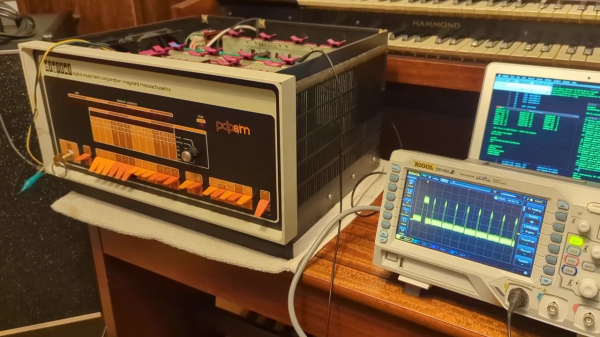Both small children and cats have a certain tendency to make loud noises at inopportune times, but what if there were a way to combine these auditory effects? This seems to have been the reasoning behind the creation of the Meowsic keyboard, a children’s keyboard that renders notes as cats’ meows. [Steve Gilissen], an appreciator of unusual electronic instruments, discovered that while there had been projects that turned the Meowsic keyboard into a MIDI output device, no one had yet added MIDI input to it, which of course spurred the creation of his Meowsic MIDI adapter.
The switches in the keys of the original keyboard form a matrix of rows and columns, so that creating a connection between a particular row and column plays a certain note. [Steve]’s plan was to have a microcontroller read MIDI input, then connect the appropriate row and column to play the desired note. The first step was to use a small length of wire to connect rows and columns, thus manually mapping connections to notes. After this tedious step, he designed a PCB that hosts an Arduino Nano to accept input, two MCP23017 GPIO expanders to give it enough outputs, and CD4066BE CMOS switches to trigger the connections.
Continue reading “Meowsic Keyboard MIDI Adapter Aims For Purrfection”
musical synthesizer4 Articles
PDP-8 Plays Period Popcorn Piece
[Kyle Owen], collector of antique tech, decided to try his hand at music arrangement — for the PDP-8 computer, that is (listen to the video below the break). He’s using a program submitted by Richard Wilson to the Digital Equipment Corporation Users Society (DECUS) in 1976, appropriately named MUSIC. It runs on OS/8 and is written in the PDP-8 assembly language PAL8. Using the syntax of MUSIC, [Kyle] arranged Gershon Kingsley’s famous Moog synthesizer hit “Popcorn” (the Hot Butter version from 1972).
You might notice the lack of a disk or tape drive in his setup. That’s because [Kyle] is using an RK05 disk emulator he wrote back in 2014. It’s running on a Raspberry Pi and connects over serial, which he says is slower than an RK05 but faster than a tape drive. He has connected up a Cordovox amplifier cabinet for this demonstration, but the original means of listening to the MUSIC output was an AM radio held near the computer (hear the second video below the break). This worked by executing the PDP-8 CAF instruction at a desired frequency, say 440 Hz.
Thus, when this instruction is executed, logic all over the computer goes “zap”, clearing out various registers. Now, if a radio is held close to the computer, it will pick up some of this energy, and at 440 times a second, will deliver a pulse to the speaker. The result is that you will hear a tone from the radio — as a matter of fact, you will hear an A.
Logic Noise: More CMOS Cowbell!
Logic Noise is an exploration of building raw synthesizers with CMOS logic chips. This session, we’ll tackle things like bells, gongs, cymbals and yes, cowbells that have a high degree of non-harmonically related content in them.
Metallic Sounds: The XOR
I use the term “Non-harmonic” in the sense that the frequencies that compose the sound aren’t even integer multiples of some fundamental pitch as is the case with a guitar string or even our square waves. To make these metallic sounds, we’re going to need to mess things up a little bit, and the logic function we’re introducing today to do it is the exclusive-or (XOR).
Musical Pencil Synthesizer

Here’s another fun weekend project for the hacker younglings, a musical synthesizer that plays different musical tones based on the resistance of your conductive graphite drawing!
Like our recent post on a DIY Metal Detector, this project makes use of the ever relevant 555 timer. Except in this case they are using a more modern TLC555 timer which only requires 3V instead of the typical 4.5V. It’s a fairly simple project that you should be able to complete in just a few hours.
The circuit is quite basic. The 555 timer outputs in astable mode, which means there is a continuous stream of pulses from pin 3 which go right into the speaker circuit. The rest of the circuit monitors the resistance of whatever the pencil is touching, including you! Changes in resistance result in the variation of pulses outputted by the 555 timer.
As always, the video guide is after the break.













